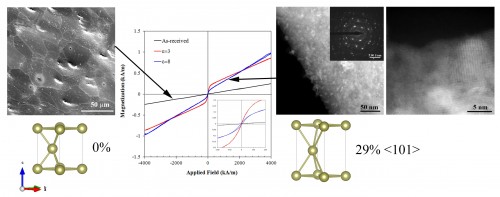Research lines
Novel room temperature magnets by elastic strain engineering
The discovery of magnets with high Curie temperatures (Tc) is of great practical interest. The vast majority of metals are considered non-magnetic since, although they can be weakly magnetized in the presence of an external field, their magnetization vanishes once the field is withdrawn. Room temperature ferromagnetism is indeed a rare phenomenon, exhibited only by four pure metals, namely Fe (Tc= 770°C), Co (Tc= 1115°C), Ni (Tc= 354°C), and Gd (Tc= 16°C).
We have succeeded to trigger room temperature ferromagnetism in several classic paramagnets such as titanium, zirconium, hafnium and magnesium. A combined approach including density functional theory (DFT) calculations and transmission electron microscopy (TEM) has confirmed that the lattice distorsions induced by grain refinement of these metals down to the nanocrystalline regime, via severe plastic deformation, lead to the development of new crystalline structures with unprecedented magnetic behavior. We believe this approach can be utilized to design novel materials with a unique combination of mechanical and functional properties.
(Left) Coarse grained pure paramagnetic Hafnium; (Right) Monoclinic room temperature ferromagnetic hafnium developed by nanocrystallization.
More information about our research in this area can be found @ Cepeda-Jimenez et al. Acta Materialia, 2017 and Cepeda-Jimenez et al. Scripta Materialia, 2016.



